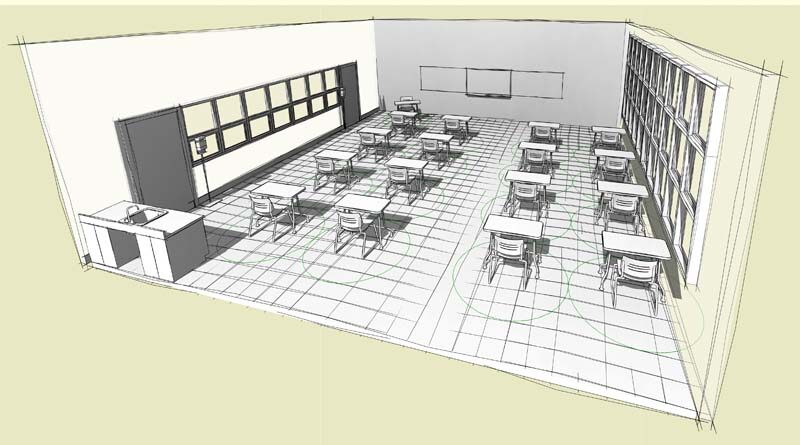Resilient School Design and Lessons Learned from COVID-19
By Clarke Forrest
When schools shut down in response to the COVID-19 pandemic, society became acutely aware of the significant roles our educational system fulfills. Above and beyond an education, schools provide meals to families struggling with food security and supervision that enables parents to go to work. Redesigning our approach to schools so they can effectively serve our communities is essential to thriving in the new normal. Districts are scrambling to create back-to-school plans to keep students and teachers safe and still foster a learning environment. While specifics vary from district to district, even from school to school, based on unique needs and circumstances, most involve some combination of virtual learning and on campus time options.
Immediate Solutions
Most immediate solutions must adapt process and behavior around existing facilities: staggered start times, staggered recess and passing periods, spacing out desks, limiting bathroom capacities, designating floors or buildings to specific student groups, adding filters to HVAC systems, mask wearing, frequent handwashing, and keeping the same group of students and teacher together through-out the day. These measures address both hygiene and allows for the isolation and quarantine of a specific group should a student or teacher become infected.
While weathering the current state of affairs by implementing these measures can mitigate the spread, it does rely heavily on teachers, aids, administration and students’ cognizance of their behaviors, such as frequent handwashing and wearing masks, especially in light of July 9 statements by the World Health Organization that current evidence suggests the virus is airborne, capable of spreading through aerosol and not specifically through droplets. In acknowledgement of the limitations of social distance requirements and existing facilities, the educational system is adjusting how they measure instruction. For instance, the state of California recently lowered the number of seat hours requirements, a metric based on how many in-person/in-class instructional hours a student must have in a given academic year.
Forward-Looking Solutions
Immediate responses to keep students and staff safe seem to be more of an exercise in organization but evaluating how current school design is falling short in the face of a pandemic provides an opportunity to innovate new school designs that will be more resilient in the future. Though many of these ideas have existed in architecture for literally thousands of years, the introduction and our subsequent reliance upon mechanical systems alongside theories that eliminating distractions from nature and natural light would help students focus resulted in their abandonment.
We must assume that for now, we’ll still have to comply with established district standards. While we cannot anticipate with any degree of certainty whether classroom size will increase or decrease, there are elements that can be reintroduced into school design immediately to facilitate healthier school environments. For one, multiple hand washing stations in each classroom makes it easier to keep hands clean, wash masks, and generally practice good hygiene. Making all restrooms single occupancy makes them easier to keep clean and addresses social issues that we are becoming more conscious of.
In addition to addressing these obvious sanitation issues, in more temperate climates, designing spaces with operable windows to promote natural ventilation through a stack affect: low windows or vents, typically on the south facing wall of a classroom if possible, and high awning windows on the north side of the room allows hot air to move out through the high windows while drawing cool air in through the lower windows. In addition to increased natural air circulation, this allows for the opportunity to increase the amount of available natural light and a view to exterior spaces, which have been proven to increase information uptake and concentration in students.
In recent years, it has become more accepted that there is no “right way” to learn. As a result, teachers have embraced alternative classroom layouts and seating, allowing students to find what works for them. Not only has this approach yielded unquestionably strong positive response from the students and enhanced academic performance, it is easier to reorganize these classroom spaces into socially distanced arrangements.
Going a step further, taking classrooms outside where possible or even using roll up doors that allow for a blurred boundary between indoor and outdoor space increases the natural ventilation that limits the spread of airborne disease and fosters a positive learning environment. This could mean longer overhangs that shade the classrooms and can shelter students from inclement weather if it otherwise allows for outside learning. This could also mean classrooms opening into a courtyard that doubles as a larger outdoor multipurpose space.
Creative, flexible spaces, which are more adaptable to approaches both towards teaching and student learning styles, allow teachers and administrators to quickly pivot between close person-to-person interaction and socially distanced arrangements when we’re faced with another event that requires us to do so.
With 14 years of experience as a designer and project manager on educational projects, Clarke Forrest of Dahlin Group Architecture Planning brings a multi-skilled and fine-tuned approach to all facets of educational architecture.

